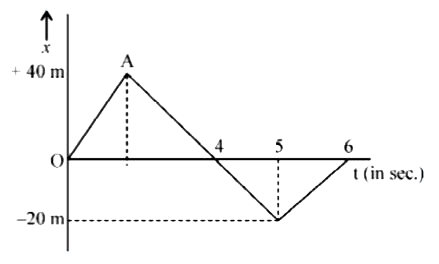A : If speed of a particle is never zero than it may have zero averag speed.
R : The average speed of a moving object in a closed path is zero.
If both Assertion & Reason are true and the reason is the correct explanation of the assertion, then mark (1).
If both Assertion & Reason are true but the reason is not the correct explanation of the assertion, then mark (2).
If Assertion is true statement but Reason is false, then mark (3).
If both Assertion and Reason are false statement, then mark (4).
The correct Answer is:4
To solve the question, we need to analyze both the assertion and the reason provided.
1. Understanding the Assertion:
- The assertion states: "If the speed of a particle is never zero, then it may have zero average speed."
- Speed is defined as the distance traveled divided by the time taken. If speed is never zero, it implies that the particle is always moving.
- Average speed is calculated as total distance traveled divided by total time taken. Since the particle is always moving, the total distance cannot be zero, which means the average speed cannot be zero. Therefore, the assertion is false.
2. Understanding the Reason:
- The reason states: "The average speed of a moving object in a closed path is zero."
- Average speed is defined as total distance traveled divided by total time taken. In a closed path, the object returns to its starting point, but this does not imply that the total distance traveled is zero. In fact, the total distance is the length of the path taken, which is positive. Hence, the average speed cannot be zero. Therefore, the reason is also false.
3. Conclusion:
- Since both the assertion and the reason are false, we conclude that the correct answer is option 4: "If both assertion and reason are false, then mark 4."
Final Answer:
The correct option is 4 (both assertion and reason are false).
---
- The assertion states: "If the speed of a particle is never zero, then it may have zero average speed."
- Speed is defined as the distance traveled divided by the time taken. If speed is never zero, it implies that the particle is always moving.
- Average speed is calculated as total distance traveled divided by total time taken. Since the particle is always moving, the total distance cannot be zero, which means the average speed cannot be zero. Therefore, the assertion is false.
- The reason states: "The average speed of a moving object in a closed path is zero."
- Average speed is defined as total distance traveled divided by total time taken. In a closed path, the object returns to its starting point, but this does not imply that the total distance traveled is zero. In fact, the total distance is the length of the path taken, which is positive. Hence, the average speed cannot be zero. Therefore, the reason is also false.
- Since both the assertion and the reason are false, we conclude that the correct answer is option 4: "If both assertion and reason are false, then mark 4."
The correct option is 4 (both assertion and reason are false).
Topper's Solved these Questions
- BOOK - AAKASH INSTITUTE ENGLISHCHAPTER - MOTION IN A STRAIGHT LINEEXERCISE - ASSIGNMENT (SECTION - C)36videos
MOTION IN A STRAIGHT LINE
- BOOK - AAKASH INSTITUTE ENGLISHCHAPTER - MOTION IN A PLANEEXERCISE - Assignement section -J (Aakash Challengers Questions)7videos
MOTION IN A PLANE
- BOOK - AAKASH INSTITUTE ENGLISHCHAPTER - MOTION IN STRAIGHT LINEEXERCISE - Assignment (SECTION - J)2videos
MOTION IN STRAIGHT LINE
Similar Questions
When is the instantaneous speed same as the average speed ?
View SolutionDefine average speed and r.m.s. speed of a gas molecule.
View Solutions-t graph of a particle in motion is shown in Fig. Calculate

Average speedView SolutionAssertion : On a curved path, average speed of a particle can never be equal to average velocity.
Reason : Average speed is total distance travelled divided by total time. Whereas average velocity is, final velocity plus initial velocity divided by two.View SolutionAn object travels 20 m in 10 s. What is the average speed of the object ?
View SolutionMaximum speed of a particle in simple harmonic motion is vmax. Then average speed of this particle in one time period is equal to
View SolutionThe ratio of the average speed of oxygen molecules to the average speed of hydrogen molecule at same temperature is
View SolutionConsider the motion of the tip of the minute hand of a clock.In one hour
a)The displacement is zero
b)The distance covered is zero
c)The average speed is zero
d)The average velocity is zeroView Solution(A):Average speed is equal to total distance travelled divided by total time taken .
(R ):The average speed of an object may be equal to arithmetic mean of individual speedView SolutionWhat is the significance of average velocity or average speed?
View Solution

